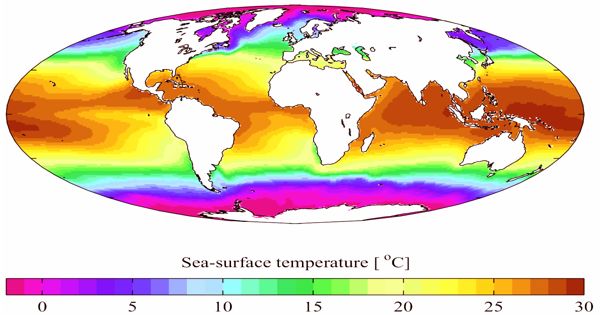Sea surface temperature (SST) is the water temperature close to the ocean’s surface. These are the most common use of thermal satellite data over aquatic targets, although when focusing on inland water bodies (i.e., lakes and reservoirs), several factors must be considered. The exact meaning of surface varies according to the measurement method used, but it is between 1 millimeter (0.04 in) and 20 meters (70 ft) below the sea surface. SST is a strong indicator of productivity, pollution, and global climate change, and this can be measured using thermal infrared (IR) bands from optical satellites. The primary cause of rising SST levels worldwide is climate warming due to excessive amounts of greenhouse gases being released into the atmosphere.
Sea surface temperatures have a large influence on climate and weather. It is an essential climate variable for understanding the climate system and quantifying ongoing climatic change.
Air masses in the Earth’s atmosphere are highly modified by sea surface temperatures within a short distance of the shore. Sea surface temperature increased during the 20th century and continues to rise. From 1901 through 2015, the temperature rose at an average rate of 0.13°F per decade. Localized areas of heavy snow can form in bands downwind of warm water bodies within an otherwise cold air mass. The surface temperature of the world’s oceans varies mainly with latitude, with the warmest waters generally near the equator and the coldest waters in the Arctic and Antarctic regions.

Fig: Annual mean sea-surface temperature changes in HadCM3
Warm sea surface temperatures are known to be a cause of tropical cyclogenesis over the Earth’s oceans. Changes in sea surface temperature vary regionally. Tropical cyclones can also cause a cool wake, due to turbulent mixing of the upper 30 meters (100 ft) of the ocean. While most parts of the world’s oceans have seen the temperature rise, a few areas have actually experienced cooling—for example, parts of the North Atlantic. SST largely controls the atmospheric response to the ocean at both weather and climate time scales. Daily variations in SST can exceed 3 degrees Celsius and could alter the surface energy budget by more than 10 Wm-2 over the tropics and subtropics.
Sea Surface temperature is a vital component of the climate system as it exerts a major influence on the exchanges of energy, momentum, and gases between the ocean and atmosphere. SST changes diurnally, like the air above it, but to a lesser degree. There is less SST variation on breezy days than on calm days. On a smaller scale, ocean temperatures influence the development of tropical cyclones (hurricanes and typhoons), which draw energy from warm ocean waters to form and intensify. In addition, ocean currents such as the Atlantic Multidecadal Oscillation (AMO), can affect SST’s on multi-decadal time scales, a major impact results from the global thermohaline circulation, which affects average SST significantly throughout most of the world’s oceans.
Information Source:
















